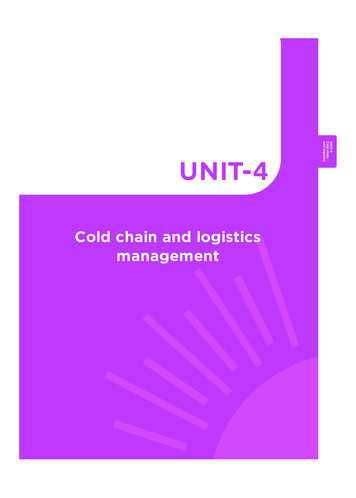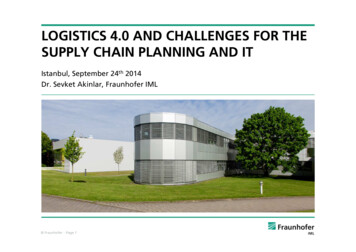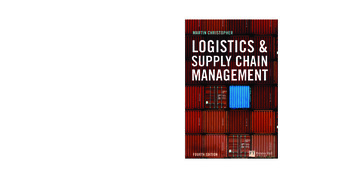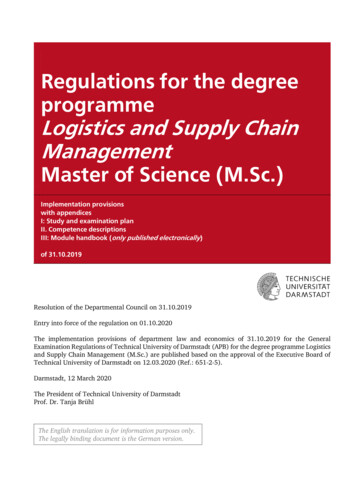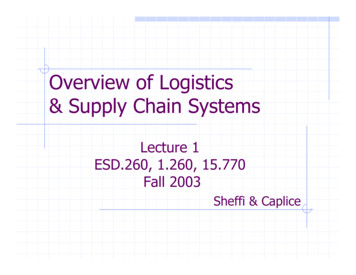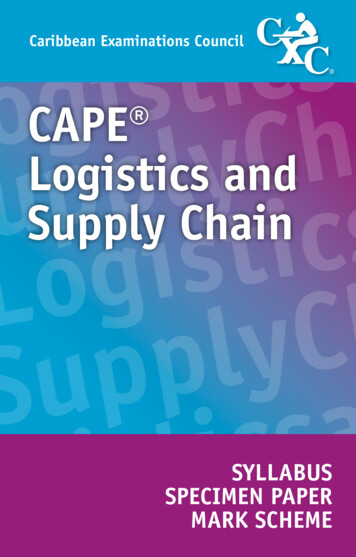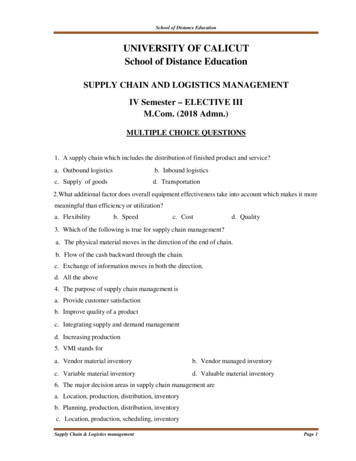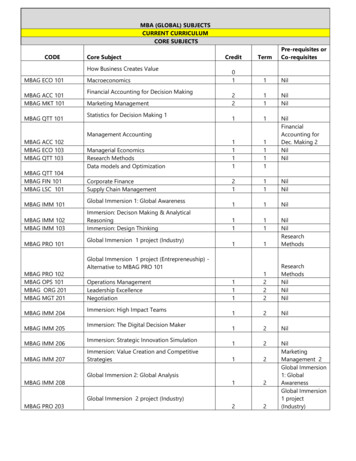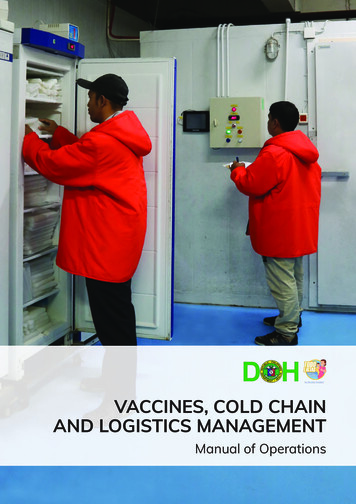
Transcription
VACCINES, COLD CHAINAND LOGISTICS MANAGEMENTManual of Operations
Department of HealthNational Immunization ProgramVACCINES, COLDCHAIN AND LOGISTICSMANAGEMENTManual of Operations5TH EDITION2018MANILA, PHILIPPINES
Table of ContentsTable of Contents3List of Figures5List of Tables6List of Annexes7Foreword8Acknowledgements9Technical Terms and Acronyms10Introduction to the Manual13Chapter 1. The Philippines’ Cold Chain System151.11.21.31.418191921The Cold Chain SystemHealth Facility Cold Chain EquipmentVaccines in the National Immunization ProgramRoles and Functions of Staff Managing the Cold Chain atDifferent LevelsChapter 2. Guiding Principles For Vaccine and Cold Chain 4363639404243454750Wastage Rate and Wastage FactorMulti-Dose Vial Policy (MDVP)Buffer StockMonitoring Vaccine and Safe Injection EquipmentBundling of Vaccines and Immunization SupplyThe Shake TestFirst Expiry, First Out (FEFO) PrincipleThe Vaccine Vial Monitor (VVM)Minimum and Maximum Vaccine Stock LevelFreezing and Conditioning Ice PacksProper Care of Vaccines during Defrosting of Cold Chain EquipmentChapter 3. Calculating and Requesting Vaccines and Safe Injection Equipment513.13.23.35456573.4Estimating Annual Vaccine RequirementEstimating Annual Requirement for Injection Safety DevicesDetermining Quantity of Vaccines and Safety Injection Equipmentto be OrderedPlacing Orders using the Vaccine and Safe Injection EquipmentRequest Form64Introduction3
Chapter 4. Receiving Vaccines and Safe Injection Equipment694.172Pre-Arrival and Arrival of VaccinesChapter 5. Storing Vaccines and Safe Injection 0818484899396100102105105107Guidelines for Storing Safe Injection EquipmentHeat and Freeze Sensitivity of VaccinesTemperature Sensitivity of Immunization SuppliesTemperature Monitoring DevicesTemperature Monitoring and RecordingTemperature MappingEstimating Storage RequirementsDetermining the Existing Cold Chain CapacityCalculation of Required Vaccine Storage CapacityEstimating Storage Capacity of Cold Boxes and Vaccine CarriersTypes of Refrigeration Equipment for Vaccine StorageGuide for Proper Arrangement of Vaccines inside the Cold Chain EquipmentChapter 6. Distribution and Transport of Vaccines and Safe Injection Equipment1136.16.26.36.46.5116117118119121Supplies Distribution PlanRecommended Actions before and during Transport of VaccinesPassive Containers (Cold Box or Vaccine Carrier)How to Arrange Vaccines in Cold Boxes and Vaccine CarriersMaintaining the Correct Temperature of Vaccines in Cold Boxes andVaccine CarriersChapter 7. Preventive Maintenance of Cold Chain Equipment1237.17.27.37.4126132133134Preventive Maintenance Guide for Cold and Freezer RoomsRecommended Actions if Storage Temperatures are Out of RangeDefrosting Vaccine RefrigeratorsGeneral Care of Cold Chain EquipmentChapter 8. Contingency Plan1378.18.28.3140140141Key Elements of a Contingency PlanActions to an Emergency at a Fixed Storage LocationPossible EmergenciesList of References4Vaccine, Cold Chain and Logistics Management Manual of Operations144
List of FiguresNumber 282930The cold chain systemProportion of MMR vaccine wasted in Health Center ASamples of frozen vaccine vials of Tetanus toxoid (right) and DPT (left)Interpreting the Shake Test resultVaccine vial with an expiration dateVVM label locationsVVM label at varying stagesHow to interpret the vaccine vial monitorSample of ice packsLayering Ice Packs inside the FreezerChecking Conditioned Ice PacksSample of Vaccine Usage and Wastage Reporting FormSample of Vaccine Usage and Wastage Consolidation DatabaseSample of Graphical Report Generated by the Vaccine Usage and Wastage DatabaseSample of Vaccine Request FormSample of Safe Injection Equipment Request FormSample of Temperature Monitoring Chart used per Cold Chain EquipmentSensor LocationSample of A Sketch of a Walk-in Cold Room with MeasurementsCalculating the Existing Vaccine Storage Capacity of a Front-Opening Refrigeratorand FreezerMeasuring the Dimension of Top-Opening Refrigerator or FreezerDecision Tree in Selecting a Refrigerator or FreezerWalk-In Cold Room and ShelvingVaccine Arrangement in a Front-Opening RefrigeratorLoading Vaccines in a Top-Opening Refrigerator with BasketLoading Vaccines in a Top-Opening Refrigerator without BasketsSamples of Vaccine Transport Box and Vaccine Carrier and the Proper Arrangementof Ice PacksHow to Load a Vaccine CarrierFive Steps in Preparing a Cold Box for Vaccine ShipmentUse of Foam Pad to Secure Opened Vaccine Vial in a Vaccine CarrierIntroduction5
List of TablesNumber Title123456789101112131415161718192021222324 a24 b25262728296List of NIP Vaccines and Recommended Doses and Storage TemperatureCauses of Vaccine Wastage in Unopened and Opened VialsVaccine Wastage Rate and Corresponding Vaccine Wastage FactorDOH-Recommended Buffer Stock Level and Usual Distribution CycleMain Indicators in Monitoring Vaccines and Immunization SuppliesExample of Calculating Bundled Vaccination Logistics in an Area with a Total Populationof 130,000Types of VVM Attached to Different Vaccine TypeVaccine Stock CardSpecifications of Injection Devices and Corresponding Wastage FactorGuide for Completing the Vaccine Usage and Wastage Reporting FormGuide for Completing the Vaccine and Safe Injection Equipment Request FormRecommended Timeliness of Submitting Vaccine OrdersRecommended Actions during Vaccines Pre-Arrival and ArrivalChecking the Status of Ice Packs upon Vaccine Arrival and Recommended ActionRecommended Storage Temperature of Vaccine and DiluentsVaccines’ Sensitivity to Various TemperaturesCauses of Heat Exposure and Recommended ActionsCauses of Freeze Exposure and Recommended ActionsTemperature Monitoring Options in Health FacilitiesTypes of Vaccine RefrigeratorsAction Points for Cold Rooms and Vaccine RefrigeratorsAction Points for Freezer Rooms and FreezersSensor List for Temperature MappingSample Estimation of Total Required Storage Volume for VaccinesGuide for Using the Tool for Estimating Total Storage Volume Required for VaccinesGuide for Using the Tool for Estimating Total Storage Volume Required for SafeInjection EquipmentSample Estimation of Total Required Storage Volume for Safe Injection EquipmentSample Data on Storage Capacity of WHO Prequalified Refrigerators and Freezersper PQSSample Form of Vaccines and Immunization Supplies Distribution PlanRecommended Actions if Storage Temperature are Out of RangeVaccine, Cold Chain and Logistics Management Manual of Operations
List of 4TitleTool for Bundling CalculationStock Management RecordStock Count for Syringes, Safety Boxes and Other ProductsVaccine Usage and Wastage Reporting - Form1Vaccine Usage and Wastage Database - Form2Vaccine Request Form (Revised, June 2017)Invoice Receipt of PropertyVaccine Arrival Report v. 2Vaccine Arrival Report for PPV23 and FluBill of LadingDifferent Types of Temperature Monitoring DevicesTemperature Monitoring ChartSensor Data Recording SheetSensor Replacement for Temperature MappingEstimating Vaccine Storage RequirementWorksheets for Estimating Required Vaccine Storage VolumeWorksheets for Estimating Required Refrigeration CapacityEstimating Safe Injection Equipment Storage RequirementCold Chain Inventory FormTool for Estimating Available Cold Room Net Storage CapacityTool for Recording Available PQS Cold Chain Storage VolumeVaccine Allocation and Distribution PlanProperty Transfer ReportEmergency Situations Requiring Contingency PlanIntroduction7
ForewordThe Department of Health presents this5th edition of the Cold Chain and LogisticsManagement Manual of the PhilippineNational Immunization Program. It containsupdates on standards and procedures,aimed at enhancing knowledge and skillsof health workers in the delivery of qualitybasic immunization services, particularly inproperly managing the vaccine cold chain.Cold chain management requires specialskills, and is a very important component ofthe program.The country has protected many infants and children against vaccine-preventablediseases either through the routine or mass immunization campaigns nationwide. Serviceproviders need to be responsive as the immunization program expands to cover other agegroups coupled with the introduction of new vaccines. Vaccine-preventable diseases affectnot only newborns, infants, children and pregnant women but also compromise the healthand welfare of other vulnerable groups like adolescents and the elderly.An adequate and readily available supply of vaccines in health facilities is critical to thedelivery of immunization services. The protective potentials of vaccines cannot be realizedwithout the availability of potent vaccines and their proper storage and management.Secretary Francisco T. Duque III, MD, MScSecretary of HealthDepartment of Health, Philippines8Vaccine, Cold Chain and Logistics Management Manual of Operations
AcknowledgmentsThe Department of Health would like to acknowledge the support of the World HealthOrganization (WHO) and the United Nations Children’s Fund (UNICEF) in the developmentof this Vaccines, Cold Chain & Logistics Management Manual of Operation.Introduction9
Technical Terms and AcronymsADS Auto-Disabled syringeAVR Automatic Voltage RegulatorAEFI Adverse Events Following ImmunizationBCG Bacillus Calmette GuerinBHS Barangay Health StationBOC Bureau of CustomsbOPV Bivalent Oral Polio Vaccine C CelsiusCm Centimetercm³ Cubic centimeterCTC Controlled Temperature ChainDOH Department of HealthDOH CO Department of Health Central OfficeDOH RO Department of Health Regional OfficeDTP-HepB-Hib Diphtheria, Pertussis, Tetanus-Hepatitis B-Haemophilus influenzae type bDTRs Daily Temperature RecordersEPI Expanded Program on ImmunizationEVM Effective Vaccine ManagementFDA Food and Drug AdministrationFEFO First Expiry First OutFIC Fully Immunized ChildHEPb Hepatitis BHPV Human Papilloma VirusIPV Inactivated Polio VaccineJE Japanese EncephalitisLGU Local Government UnitLMD Logistics Management Divisionm³ Cubic meterMCV Measles-Containing VaccineMDVP Multi-Dose Vial PolicyMMR Measles Mumps RubellaMR Measles RubellaNIP National Immunization ProgramNIST US National Institute of Standards and TechnologyPCM Phase Change MaterialPCV Pneumococcal Conjugate Vaccine10Vaccine, Cold Chain and Logistics Management Manual of Operations
PPE Personal Protective EquipmentPPV Pneumococcal Polysaccharide VaccinePQS Performance, Quality and SafetyRHU Rural Health UnitRITM Research Institute for Tropical MedicineSDD Supply and Distribution DepartmentTd Tetanus diphtheriaTP Total PopulationTT Tetanus ToxoidUNICEF United Nations Children’s FundVAR Vaccine Arrival ReportVVM Vaccine Vial MonitorWF Wastage FactorWHO World Health OrganizationWR Wastage RateIntroduction11
IntroductionVaccines and their management form a major component ofthe National Immunization Program (NIP). The regular supplyof vaccines and their efficient management are essential to thesuccess and effectiveness of all immunization programs.Intensified introduction of new vaccines, updated policiesand procedures, and emerging recently developed cold chainequipment have major impact on the immunization system. Theexisting cold chain and logistics management manual (4th edition,2005) needs to be revised to reflect the current challenges andinnovations regarding vaccine supply and its logistics system.This manual aims to develop and enhance the knowledge andskills of immunization service providers, NIP managers, and coldchain managers to effectively manage vaccines and immunizationlogistics. It provides guidance on key activities at every level ofthe cold chain system: calculating requirements, requisitioning,receiving, storing, distributing and monitoring vaccine use andwastage as well as implementing contingency plans.The guidelines contained here apply to vaccines under the NIP.However, the general principles of vaccines and cold chainmanagement apply to all vaccines, including those available inthe private sector.Introduction13
Chapter 1THE PHILIPPINES’COLD CHAIN SYSTEM
CHAPTER 1The Philippines’ Cold Chain SystemVaccines are temperature-sensitive biological products; thus, recommendedstorage temperatures for vaccines and diluents should be strictly maintainedat all levels of the cold chain.To ensure safety and potency of vaccines in protecting individuals againstvaccine-preventable diseases (VPDs), all immunization and cold chain staffmust know and carry out the correct handling and management of vaccinesand immunization supplies.At the end of this chapter, the health worker will be able to: Understand the vaccine cold chain system; Identify the vaccines in the national immunization schedule and theirrecommended storage temperatures; and, Understand the roles and functions of the NIP Manager/Coordinators andCold Chain Manager at different levels.Chapter 1 The Philippines’ Cold Chain System17
The Cold Chain System1.1The cold chain is a system for storing and transporting vaccines in good condition from themanufacturer to the person being immunized. The system includes vaccines, immunizationsupplies and cold chain equipment. It is also referred to as the vaccine supply chain.A complete cold chain system is illustrated in Figure 1. The series of arrows at the bottomof the figure show the flow of vaccines down to the health facilities; the series at thetop show where data are collected, recorded, checked and analyzed and how reportinginformation flows back up the chain. Following this sequence ensures that cold chainperformance is properly monitored and the necessary information is gathered to aidvaccine forecasting.In the Philippines, vaccines and immunization supplies are stored and managed atdifferent locations. It is therefore important to plan and coordinate the delivery of vaccinesand other immunization supplies to ensure that all health centers and other servicedelivery points are provided with adequate vaccines; correct diluents; and adequatesyringes, droppers, and safety boxes.FIGURE 1.The cold chain systemManufacturerRequest forsupplyAnnual statisticsand estimatesAirport/SeaportAnalysisMonthly report/checkingCentral storeDailyrecordSubnational storeHealth centreVaccinator/mother and child18Vaccine, Cold Chain and Logistics Management Manual of Operations
1.2Health Facility Cold Chain EquipmentDifferent levels within the national cold chain system require different types of equipmentfor transporting and storing vaccines and diluents within the required temperature range.1.2.1 National (Primary Level)Depending on the capacity required, cold or freezer rooms, refrigerators, cold boxes, and insome cases, refrigerated trucks for transportation are used at the primary level.1.2.2 Regional (Secondary Level)Depending on the capacity required, the secondary level generally uses equipment similarto the primary level, such as cold or freezer rooms, refrigerators, cold boxes, and in somecases, refrigerated trucks for transportation.1.2.3 Province / City (Intermediate Level)Depending on the capacity required, cold or freezer rooms and/or freezers, refrigerators,cold boxes, and in some cases, refrigerated trucks for transportation are used at this level.1.2.4 Health Center, Health Facility or Health Post (Peripheral Level)Depending on the capacity required, refrigerators (in certain cases, with water packfreezing/cooling compartment), cold boxes and vaccine carriers are needed at this level.1.3Vaccines in the National ImmunizationProgramThe immunization program in the Philippines started in 1976 with the first set ofvaccines against the six common childhood illnesses: tuberculosis, diphtheria, pertussis,poliomyelitis, measles and tetanus. Since then, the Department of Health (DOH) graduallyexpanded the types of vaccines used in the National Immunization Program (NIP).Chapter 1 The Philippines’ Cold Chain System19
TABLE 1.List of NIP vaccines, recommended doses and storage temperatureVaccine typeVaccinecompositionNo. dosesper vialVVMTypeRequiredWastage rateroutine doses (wastage factor)RemarksNegative Storage Temperature (-15 C to -25 C)bOPVPolio (live20attenuatedbivalent oral poliovaccine)23 doses25% (1.33)Store at -15 Cto -25 C at thenational, regional,provincial/city levels.For RHU/HC/BHU:store at 2 C to 8 C temperaturePositive Storage Temperature ( 2 C to 8 C)MMRMeasles, mumpsand rubella5142 doses25% (1.33)Can be safelystored attemperatures of-15 C to -25 C or 2 C to 8 CMRMeasles andrubella10142 doses25% (1.33)Can be safelystored attemperatures of-15 C to -25 C or 2 C to 8 CBCGBacillus Calmette 20Guerin301 dose50% - 75%(2.00 - 2.50)Not damagedby freezing butampoules maybreakHepBHepatitis B301 dose15% (1.18)Damaged -HepatitisB-Haemophilusinfluenzae type b143 doses5% (1.05)Damaged byfreezingTdTetanus anddiphtheria142 doses pertarget15% (1.18)Damaged byfreezing.IPVPolio (inactivated) 1071 dose15% (1.18)Damaged byfreezingPCVPneumococcal1conjugate vaccine303 doses5% (1.05)Damaged byfreezingJEJapaneseencephalitis5141 dose25% (1.33)Damaged byfreezingHPV*Human Papilloma 1Virus302 doses5% (1.05)Damaged byfreezing.Rotavirus*Rotavirus1None2 doses5% (1.05)Damaged e2 doses5% (1.05)Damaged byfreezing.FluInfluenza10None2 doses15% (1.18)Damaged byfreezing.1010* Some vaccines are based on the prioritization of the target population20Vaccine, Cold Chain and Logistics Management Manual of Operations
1.4Roles and functions of staff managingthe cold chain at different levels1.4.1 National Level1.4.1.1 National Immunization Program Develop policies, guidelines and tools relevant to cold chain and logisticsmanagement Develop an evidence-based national plan and strategy to strengthen the country’scold chain system, including during times of health emergency and disaster. Prepare an annual forecast of vaccines and immunization supplies with set standardsfor calculation of sub-national needs Procure immunization supplies such as vaccines and diluents, AD syringes, mixingsyringes, and safety collector boxes Consolidate and analyze data on inventory, vaccine utilization, and wastage Support sub-national capacity-building through technical assistance and offering/exploring training opportunities relevant to vaccine and cold chain management Conduct periodic field monitoring and supportive supervision Oversee upgrading of the national cold chain system, including resources to providecold chain equipment such as, but not limited to, vaccine carriers, cold transportboxes, vaccine fridges, ice pack freezers, cold room, cold chain temperaturemonitoring devices, and relevant information, education and communication (IEC)materials Conduct periodic national cold chain inventory and assessment of effective vaccinemanagement (EVM), including cold chain equipment functionality at all levels1.4.1.2 National Vaccine Store (SDD-RITM) Develop Policies, Guidelines, and tools for the management, storage, distribution, andtransport of vaccines in coordination with Supply Chain Management Implement the national plan to strengthen Cold Chain Management includingvaccines Maintain, manage, and analyze national database on vaccine distribution Provide inventory reports to DOH (SCM, DPCB, Finance, COA) Act as a member of the technical working group in relation to the procurement of allvaccines, supplies, and other ancillaries, if needed Ensures that vaccines are in good quality Recommends measures to DOH for the improvement, expansion, and rehabilitationChapter 1 The Philippines’ Cold Chain System21
of Cold Storage Facilities for the National Vaccine Store Support the NIP in conducting periodic field monitoring and supportive supervision toensure compliance to Standards and Guidelines Maintain and implement a contingency plan in cases of mechanical or power supplybreakdown of the National Vaccine Store with the support of the DOH Properly manage any funds provided to the National Vaccine Store Assist the NIP in the conduct of trainings related to cold chain and logisticsmanagement1.4.2 Regional Level1.4.2.1 Regional NIP Coordinator Determine annual and quarterly vaccine and immunization supply requirementfollowing the national standard of calculation and recommended buffer stock Share the regional vaccine and immunization supply allocation and distribution planwith the NIP, SDD-RITM, Regional Cold Chain Manager and Supply Officer Ensure timely and adequate receipt and delivery of vaccines and immunizationsupplies Ensure data collection, consolidation, validation, and analysis of regional data onvaccine requisition. Analyze inventory, distribution, utilization, wastage reportssubmitted by province/city, and consolidate regional report Conduct quarterly inventory of vaccines and annual inventory of cold chainequipment. Conduct field monitoring, training, and supportive supervision on cold chain andlogistics management Immediately alert the NIP and RITM SDD for any risk of vaccine stock-out at any levelof the regional vaccine supply chain Monitor functionality and recommend upgrading of the regional cold chain system, asneeded1.4.2.2 Regional Cold Chain Manager Receive, store, and manage vaccines properly Maintain cold chain facility and equipment in good condition, including maintenanceof ideal storage temperature at all times Maintain and manage the regional database on vaccines and immunization supply incoordination with the regional supply officer Coordinate with the Regional NIP coordinator to implement the regional vaccineallocation and distribution plan, making necessary adjustments based on dataanalysis on vaccine requisition, distribution, utilization, wastage, and inventory22Vaccine, Cold Chain and Logistics Management Manual of Operations
Receive, validate, and process vaccine requisitions and distribution to differentprovincial, and city and other vaccine stores Coordinate transport service to ensure timely vaccine delivery Provide quarterly reports to the Regional NIP Coordinator on the status of the coldchain, vaccines and immunization supplies Immediately alert the Regional NIP Coordinator and the provincial/city vaccine storeon any delay in vaccine delivery and impending vaccine stock-outs Support training activities related to vaccine and cold chain management Proactively report any breakdown on cold chain facility/equipment with the RegionalHealth Office Management and Regional NIP Coordinator Maintain and implement contingency plans in case of disaster, mechanical or powersupply breakdowns Monitor and record the temperature of cold chain equipment two times a day, everyday, including weekends and holidays. Monitor and record status of thermometer, Vaccine Vial Monitor (VVM), expirydate and physical condition of the vaccines and diluents prior to distribution and/oradministration1.4.3 Provincial and City Level1.4.3.1 Provincial/ City NIP Coordinator Calculate the annual and quarterly vaccine and immunization supply requirementbased on national standards and the recommended buffer stock Furnish the Regional NIP Coordinator and Cold Chain Manager with the provincial /city vaccine and immunization supply allocation and distribution plan Ensure adequate and timely receipt and delivery of vaccines and immunizationsupplies Ensure data collection, consolidation, validation, analysis of provincial/city reportsubmission on vaccine requisition, distribution, utilization, wastage, and inventory Conduct quarterly inventory of vaccines and annual inventory of cold chainequipment Conduct field monitoring, training and supportive supervision on cold chain andlogistics management Provide relevant training, and supportive supervision Immediately alert the Regional NIP Coordinator and Cold Chain Manager on risks ofvaccine stock-out at any level of the vaccine supply chain Monitor functionality and recommend upgrading of the cold chain system, as neededChapter 1 The Philippines’ Cold Chain System23
1.4.3.2 Provincial / City Vaccine and Cold Chain Manager Receive, store and manage vaccines properly Maintain cold chain faciity and equipment in good condition, including maintenanceof ideal temperatures at all times Monitor and record the temperature of cold chain equipment two times a day everyday, including weekends and holidays. Monitor and record status of thermometer, Vaccine Vial Monitor (VVM), expirydate and physical condition of the vaccines and diluents prior to distribution and/oradministration Maintain and manage the provincial / city database on vaccines and immunizationsupply, in coordination with the Logistics and Supply Officer Ensure implementation of the provincial / city vaccine allocation and distributionplan, with necessary adjustments in coordination with the Provincial NIP Coordinatorbased on analysis of vaccine requisition, distribution, utilization, wastage, andinventory data Receive, validate, and process vaccine requisitions and distribution to different healthfacilities Provide monthly report to the Provincial NIP Coordinator on status of cold chain,vaccines, and immunization supplies Immediately alert the Provincial NIP Coordinator and concerned health facilities forany delay in vaccine delivery or an impending stock-out Support training activities related to vaccine and cold chain management Proactively report any breakdown in the cold chain facility or equipment to theProvincial / City Health Office Maintenance Unit and NIP Coordinator Maintain and implement a contingency plan for disasters and mechanical or powersupply breakdowns1.4.4 Municipal Health Office/ Rural Health Unit / Health Center Level1.4.4.1 NIP Officer Calculate annual and quarterly vaccine and immunization supply requirements basedon national standards and recommended buffer stock and share the information withthe Provincial / City NIP Coordinator and Cold Chain Officer Ensure timely and adequate receipt and delivery of vaccines and immunizationsupplies Ensure monthly report submission to the Provincial NIP Coordinator and Cold ChainManager on vaccine requisition, distribution, utilization, wastage, inventory, and coldchain equipment inventory Immediately alert the Provincial / City NIP Coordinator and Cold Chain Manager onany risk of vaccine stock-out24Vaccine, Cold Chain and Logistics Management Manual of Operations
1.4.4.2 Cold Chain Officer Collect, receive, store and distribute vaccines based on national standards Acknowledge receipt of vaccines and other immunization supplies from the ProvincialNIP Coordinator and Cold Chain Manager and update the vaccine control card Monitor and record the temperature of cold chain equipment two times a day everyday, including weekends and holidays. Monitor and record status of thermometer, Vaccine Vial Monitor (VVM), expirydate and physical condition of the vaccines and diluents prior to distribution and/oradministration Prepare and submit monthly reports on vaccine requisition, inventory, utilization, andwastage, including immunization coverage data to the Provincial NIP Coordinator Maintain cold chain equipment in good working condition and submit vaccine or coldchain inventory report as requested Immediately report any breakdown in cold chain equipment to the Municipal Healthofficer and NIP coordinator Maintain and implement contingency plans in disasters and mechanical or powersupply breakdownChapter 1 The Philippines’ Cold Chain System25
Chapter 2GUIDING PRINCIPLESFOR VACCINEAND COLD CHAINMANAGEMENT
CHAPTER 2Guiding Principles for Vaccineand Cold Chain ManagementThis chapter introduces the different principles and guidelines for managingvaccines and the cold chain system.At the end of this chapter, the NIP Coordinator and Cold Chain Managerwill be able to understand the basic principles, importance and uses of thefollowing:2.1 Vaccine Wastage and Wastage Factor Multi-Dose Vial Policy (MDVP) Buffer Stock Bundling of vaccines and immunization supply The Shake Test First Expiry First Out (FEFO) Principle Vaccine Vial Monitor (VVM) Conditioning Ice Packs Minimum and Maximum Stock LevelChapter 2 Guiding Principles for Vaccine and Cold Chain Management29
2.1Wastage Rate and Wastage Factor2.1.1 Causes of Vaccine WastageWastage is defined as loss by use, erosion, damage, or through careless or extravagantuse. Wastage may happen to both opened and unopened vials.All health facilities using and storing vaccines should promptly submit a duly signed reportof wasted vaccines regardless of the cause (such as expiration, frozen vaccines, VVM atdiscard point or excessive withdrawal of vaccines from vials, theft or breakage).TABLE 2.Causes of vaccinewastage in unopenedand opened vialsVaccine wastage in unopened vialsExpirationVVM at dicard pointExposure to heat or freezingtemperaturesBreakageMissing inventoryTheftDiscarding unused vials from anoutreach sessionVaccine wastage in opened vialsDiscarding remaining doses at end ofimmunization session not in accordancewith the multi-dose vial policy (MDVP).(Refer to the latest MDVP guideline)Doses administered below the numberof doses indicated on the label of a vialPoor or improper reconstitutionpracticesOpened vials submerged in waterSuspected contaminationPatient reaction requiring more thanone doseAdministration of incorrect dosageVery few children showing up duringimmunization session30Vaccine, Cold Chain and Logistics Management Manual of Operations
2.1.2 Ways t
Management Manual of the Philippine National Immunization Program. It contains updates on standards and procedures, aimed at enhancing knowledge and skills of health workers in the delivery of quality basic immunization services, particularly in properly managing the vaccine cold chain. Cold chain management requires special
